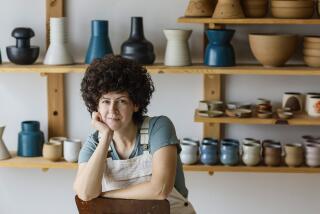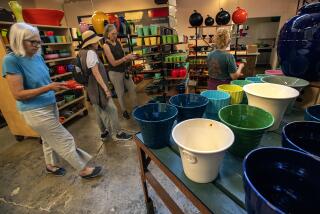Dishing Out Art in East Germany : Exquisite Meissen China Still Made the 18th-Century Way
- Share via
MEISSEN, East Germany — At the beginning of the 18th Century, pharmacist Johann Friedrich Boettger, reputedly also an alchemist, was instructed by Augustus the Strong, king of Poland and elector of Saxony, to convert base metals into gold.
Like others before him, Boettger failed, but he discovered something in the process: how to turn this region’s pale clay into fine porcelain, of such quality that it quickly became known as “white gold.”
In 1710, Boettger was ordered to set up a porcelain factory in the Albrechtsburg Castle here. Since then, Meissen porcelain, also called “Dresden china,” has been among the world’s finest.
Today, 278 years later, a staff of 1,800 is at work behind the dull gray stucco walls of the factory, which is state-run and situated 15 miles north of Dresden. Demand is such that there is a long waiting list for special orders. Sales total more than $50 million a year, and 80% of production is exported.
The distinctive Meissen (pronounced MY-s’n) trademark--crossed swords of cobalt blue--appears on every item produced here. It has probably been copied more than any other trademark.
Each piece is hand-painted with exquisite designs that are treasured by connoisseurs throughout Europe and much of the rest of the world.
“We still produce our traditional designs, those that have been popular for nearly 300 years,” Volkmar Bretschneider, head of the 550 people who make up the painting and design staff, told a recent visitor. “But we are also developing more contemporary styles for customers who prefer them, and we have also been creating porcelain wall coverings-- bas-reliefs and tile paintings.”
In Bretschneider’s studio are colorful designs that have been painted on porcelain and glazed, creating “pictures” that can be hung like canvases.
He said there is renewed interest in murals made of porcelain tiles, like those in the Dresden Palace, which survived Allied bombing in the great air raid of 1945.
Production of Meissen porcelain is limited by the number of painters at the factory. Some pieces are left white and unadorned, but most are hand-painted before the final glazing.
“It takes us a long time to train painters,” Bretschneider said. “Most begin as apprentices in the factory school. Some go off to college to study art and return as career members of our painting department.”
Once they are here, most Meissen workers make their jobs a lifelong career. Bretschneider started here 43 years ago, at age 14.
Another artist, Kurt Baessler, tops them all. He, too, started at 14, and recently celebrated his 75th anniversary as a painter of flowers.
“I cannot imagine my life without porcelain,” he said, “more precisely, without Meissen.”
In a studio workroom adjoining Bretschneider’s, men and women were bent over cups, saucers, plates, tureens, figurines, vases and room decorations, painstakingly adorning them with flowers, birds, animals, rural scenes, Oriental designs.
Bearded painter Klaus Teichmann was working on a special order from a Swiss industrialist--a dozen huge platters with a vegetable motif.
“The order gives me a certain amount of creative freedom,” Teichmann said. “I decided to do artichokes, eggplants, all sorts of different things within a similar pattern.”
Of his years with the company, he said: “The most important thing I learned from the older generation here was their personal commitment as porcelain painters for Meissen. I always urge younger colleagues, ‘Develop your capabilities, but do it consciously, with commitment to the Meissen tradition--the special quality of the enrichment of porcelain.’ ”
Nearby, Helga Wellbach delicately painted a flower.
“We have quite a choice in our colors,” she said. “Three hundred shades of purple, for instance.”
The paints often look dull when applied. They take on their characteristic brightness only later, after being fired in the kilns.
Next to Wellbach at a wooden bench sat Andrea Eichlar, who was roughing out the design of a swallow for a plate.
“I have to pick the bird and then position it harmoniously on the plate,” she said. “In a table set, I will paint a different bird on each plate.”
Although most Meissen patterns are dictated by the buyer, within those limits the painters have the freedom to lay out the design according to their taste and even to choose the flowers or birds that will be used. It is because of this that no two Meissen pieces are exactly the same.
Not Something New
The painted designs complement the work of potters, who produce the handmade flatware, and sculptors, who model the pieces that range from tiny figurines to huge vases.
Historically, pottery--objects made of clay and hardened by heat--has been around for about 9,000 years, originally as unglazed earthenware. Stoneware, a vitrified, or glassy, product, dates from the Shang Dynasty in China, around 1400 BC.
The oldest porcelain, a translucent ware that rings when tapped, was made in China during the Tang Dynasty, AD 618-907, hence the generic term “china.”
The Chinese secret of true porcelain was hidden from the West until the pharmacist Boettger, along with physicist Ehrenfried Walther von Tschirnhaus, discovered it in Meissen. The key was to mix natural kaolin clay with feldspar, a crystalline mineral. When fired at higher temperatures than had been used before, this created a “hard” porcelain.
The first attempts produced a dark material, but the team soon managed to create a white, translucent porcelain.
Two imaginative artists, sculptor Johann Joachim Kaendler and painter Johann Gregorious Hoeroldt, the inventor of Meissen enamel colors, contributed much to the Meissen reputation. They created beautiful rococo figurines that can be seen in many museums and private collections.
Later the technique spread through Europe--to France, England and Denmark. English potters added bone ash, which created a china less likely to chip than the continental variety, and this became popular in England and the United States.
Damaged During Wat
The Meissen factory enjoyed an artistic revival in the period 1913-1933, under the supervision of Max Adolf Pfeiffer and sculptor Paul Scheurich. They created a museum and showroom that attract more than 330,000 visitors a year.
During World War II, the Meissen factory was damaged, and many valued artisans were lost. The factory was rebuilt under a Russian manager, but the last thing needed in the immediate postwar years was decorative porcelain.
Yet by 1960, Meissen was back in the fore of fine porcelain-making, with Ludwig Zepner as designer, Peter Strang as sculptor, Heinz Werner and Rudi Stolle as pattern designers and Volkmar Bretschneider as painter.
Today, the Meissen works produces not only its traditional items but others with a modern look. As Bretschneider put it: “The preservation of the old and the commitment to the new have been a principle in the creation of Meissen porcelain.”
Figurines now range from the traditional scenes from Shakespeare’s “A Midsummer Night’s Dream” to scenes from Bertolt Brecht’s “Three-Penny Opera.”
About 60% of Meissen’s production is dinnerware. The most popular in the United States is a five-piece setting: three plates, cup and saucer. A salesperson at Geary’s in Beverly Hills said prices for such a setting range from $350 to $1,105, depending on the pattern.
About 15% consists of modeled figurines, and the rest are special-order pieces--larger sculptures and wall designs.
One at a Time
Outside Meissen, workers still dig kaolin from the company mine. Only three miners are employed here, and Bretschneider calls it “the smallest mine in Germany.”
On the occasion of Meissen’s 275th anniversary, General Manager Reinhard Fichte observed: “The production of Meissen is not just a commercial task; it also involves the active execution of a cultural function. It has the duty to extend the spectrum of Meissen porcelain in the sense of modern Meissen, and also to satisfy specific demands with regard to the perfection and excellence of classical Meissen.”
The company tries to retain its balance between things past and things future, but it still makes its products one at a time. “In a world that stresses mass production,” Bretschneider said, “we still make our products and paint them by hand.”
Did he have any advice for Meissen buyers?
“We like to say that there is no problem putting our porcelain in modern dish-washing machines,” he said, “but I’m sure most housewives wash the plates and cups by hand--and very carefully.”
More to Read
Sign up for The Wild
We’ll help you find the best places to hike, bike and run, as well as the perfect silent spots for meditation and yoga.
You may occasionally receive promotional content from the Los Angeles Times.






